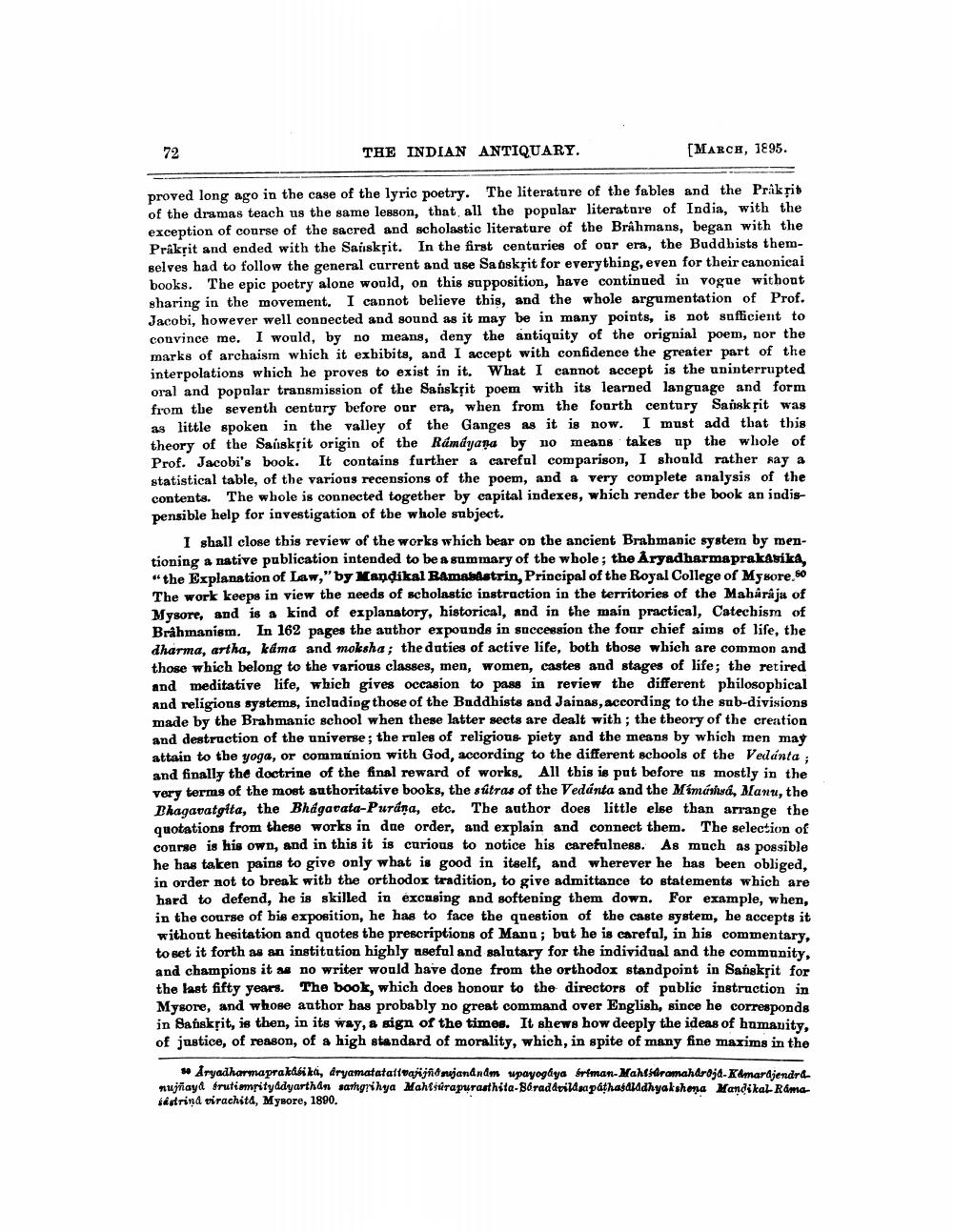________________
72
THE INDIAN ANTIQUARY.
[MARCH, 1895.
proved long ago in the case of the lyric poetry. The literature of the fables and the Praksid of the dramas teach us the same lesson, that all the popular literature of India, with the exception of course of the sacred and scholastic literature of the Brahmans, began with the Prakrit and ended with the Saiisksit. In the first centuries of our era, the Buddhists themselves had to follow the general current and use Sanskrit for everything, even for their canonical books. The epic poetry alone would, on this supposition, have continued in vogue without sharing in the movement. I cannot believe this, and the whole argumentation of Prof. Jacobi, however well connected and sound as it may be in many points, is not sufficient to convince me. I would, by no means, deny the antiquity of the orignial poem, nor the marks of archaism which it exhibits, and I accept with confidence the greater part of the interpolations which he proves to exist in it. What I cannot accept is the uninterrupted oral and popalar transmission of the Sanskțit poem with its learned language and form from the seventh century before our era, when from the fourth century Sansk șit was as little spoken in the valley of the Ganges as it is now. I must add that this theory of the Sanskrit origin of the Rámdyana by no means takes up the whole of Prof. Jacobi's book. It contains further a careful comparison, I should rather say a statistical table, of the various recensions of the poem, and a very complete analysis of the contents. The whole is connected together by capital indexes, which render the book an indis pensible help for investigation of the whole subject.
I shall close this review of the works which bear on the ancient Brahmanic systern by mentioning a native publication intended to be a summary of the whole; the Aryadharmaprakasika, "the Explanation of Law," by Mandikal Ramakstrin, Principal of the Royal College of Mysore. So The work keeps in view the needs of scholastic instruction in the territories of the Maharaja of Mysore, and is a kind of explanatory, historical, and in the main practical, Catechism of Brahmanism. In 162 pages the author expounds in succession the four chief aims of life, the dharma, artha, kama and moksha; the duties of active life, both those which are common and those which belong to the various classes, men, women, castes and stages of life; the retired and meditative life, which gives occasion to pass in review the different philosophical and religions systems, including those of the Buddhists and Jainas, according to the sub-divisions made by the Brahmanic school when these latter sects are dealt with; the theory of the creation and destruction of the universe; the rules of religious piety and the means by which men may attain to the yoga, or communion with God, according to the different schools of the Vedanta and finally the doctrine of the final reward of works. All this is put before us mostly in the very terms of the most authoritative books, the sutras of the Vedánta and the Mimánsá, Manu, the Dhagavatgita, the Bhagavata-Purána, etc. The author does little else than arrange the quotations from these works in dae order, and explain and connect them. The selection of course is his own, and in this it is curious to notice his carefulness. As much as possible he has taken pains to give only what is good in itself, and wherever he has been obliged, in order not to break with the orthodox tradition, to give admittance to statements which are hard to defend, he is skilled in excasing and softening them down. For example, when, in the course of bis exposition, he has to face the question of the caste system, he accepts it without hesitation and quotes the prescriptions of Mana; but he is careful, in his commentary, to set it forth as an institution highly aseful and salutary for the individual and the community, and champions it as no writer would have done from the orthodox standpoint in Sansksit for the last fifty years. The book, which does honour to the directors of public instruction in Mysore, and whose author bas probably no great command over English, since he corresponds in Sanskrit, is then, in its way, a sign of the times. It shews how deeply the ideas of humanity, of justice, of reason, of a high standard of morality, which, in spite of many fine maxims in the
- Aryadharma praktika, dryamatatativasjño nuandndm wpayogaya frfman Mahiramaharaja-Kamardjendr nujñaya frutiamsityadyarthan sathgrihya Mahsurapurasthita-86raduildsapathasiddhyakshema Mandikal-Ráme sestrind virachita, Mysore, 1890.




